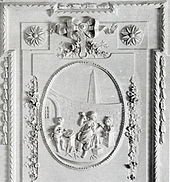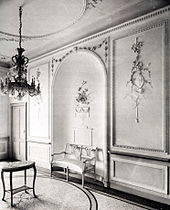Petrus Nicolaas Gagini

Petrus Nicolaas Gagini (also: Pietro Nicolo ; Petruus Nicolaas ; Petrus Nicolaus ; born January 13, 1745 in Bissone , † October 2, 1811 in Maastricht ) was a Swiss plasterer and draftsman from the canton of Ticino . It is conceivable that he descended from the Gagini / Gaggini family of sculptors who worked in Lombardy and Sicily .
Live and act
His training is unknown. The depiction of Hercules and Omphale from the period before 1770 in the Casa Cagini in Bissone has come down to us from his early work in Switzerland . Presumably he had been doing stucco work north of the Alps since 1770. Petrus Nicolaas Gagini worked in Aachen in 1778 and 1807 . He married in Maastricht in 1791 , received civil rights in 1792 and became a member of the guild of traders, the Krämerambacht, in which all professions that did not have their own guild were organized. Gagini traveled to the Netherlands in 1796 and 1800 and stayed in Leiden , among other places .
style
In the period from 1781 to 1811 Gagini made numerous interior decorations from stucco in the region of Aachen, Liège and Maastricht. The artistic work of Gagini is characterized by the representation of Italianized local architecture in a landscape. He found his own style and repertoire for his portrait medallions in addition to the traditional way of depicting the motifs from master books. In his visual language he made use of various, frequently recurring elements, such as the use of portrait medallions, flower garlands, architectural perspectives , hunting motifs , allegories of love and architecture, music, painting, sculpture and mostly lively landscapes. Gagini divides the walls and ceilings by means of fluted pilasters with Ionic capitals , entablature with tooth cut , egg stick , palmette frieze and lambrequins with frames and festoons . He often carried out the designs for the decoration orders himself. 14 of his works from the years 1781 to 1811 are signed and dated, the others are attributions .
Hans Königs suspected that Gagini's numerous lake depictions were inclined to incorporate the landscape of his homeland into the pictures. For Jakob Couven he made the pictures according to his designs. His signature: Gagini invenit et sculpsit in Eupen , Waldenburghaus and Maastricht proves that he carried out these remarks from his own sketches. Most of his representations are works of fantasy. In the large building near Aachen, real objects and landscape brands were also incorporated into the design.
Works (selection)
- 1775: Gable frieze , in the residential building at Sint-Pieterstraat 42, Maastricht (destroyed in 1930)
- 1778: Chimney piece , in the former Drimborn house, today in the Gagini room in the Couven Museum Aachen . Flower basket on a table surrounded by festoons. The signature is in two parts on the lower frame. Incised on the left: Gagini , on the right: Fecit. 1778 in cursive.
- 1780, signed: Chimney piece with Apollo and Python , Supraporte with Venus and Adonis , Mont St. Martin, Liège
- 1780–1789, sig. and dated: five chimney pieces in house Kaperberg 31–33, Eupen
- Residential building Friedrich-Wilhelm-Platz, Aachen (destroyed)
- around 1784: Stucco decorations and medallions in Rahe Palace , Aachen
- 1785 or 1788: Grotesques, putti (destroyed) in the small salon in the Hôtel de l'Amurauté, Esneux-Tilff
- 1787: Allegories of the hunt, love, the seasons and elements, Venus and Adonis , Rue Dartois, Liège (former location unknown)
- 1788: Salon, Gors-Opleeuw Castle, Borgloon / NL
- 1789: The hall in the Eyll house is decorated, Maastricht Army
- around 1789: Decorations in the Gagini room of the Stadhuis (town hall) of Maastricht, moved, downsized and rearranged from the residential building at Capucijnstraat 114
- 1794: Music salon in the Haus zur Stadt Mannheim , Komphausbadstrasse 31, Aachen, destroyed (moved to the Couven Museum in 1939)
- End of 18th century: Chimney piece in the Chambre Romaine, Borgharen Castle, Maastricht, based on Mathias Soiron's empire sketches
- Beginning 19th century: Rustenburg House, Bunde / NL (Geulerstraat)
- 1801, sign. u. dat .: garden room chimney piece with floral motif, chimney pieces with allegories, u. a. of fine arts and games, staircase decoration with gods, & the like. a. Jupiter , Jeanne d'Arc ; Ceiling design in the garden pavilion with Olympic gods (the pavilion is currently outsourced), in Haus de Grand Ry , Friedensgericht, Klötzerbahn 27, Eupen / B
- around 1801: Withuishof chimney piece in Maastricht-Amby
- 1803: a couple of diagrams in the dining room and tower room of Fort Wolfrath, Holtum / NL, Sittard-Geleen
- 1805: Allegories of the seasons and elements , Waldenburghaus also called Merols Castle, Kettenis / B, destroyed
- 1805: signed. u. dat .: Allegories and mythological figures as wall and Ceiling design of several salons, Rahe Castle, Laurensberg . Two rooms decorated for the lord of the minor councilor Gerhard Heusch.
- 1807: several wall stucco pictures in the garden room of the manor house built in 1773 on the estate Der Große Bau in Aachen-Süsterfeld.
- Soerser Hochkirchen After the destruction caused by the Second World War , Hans Königs was able to recover large parts of the reliefs applied to the clay plaster in 1945 and temporarily store them in the Suermondt Museum . Since 1968 restoration and addition by the restorer Josef Souchill as decoration for the Handel Hall in the Alten Kurhaus Aachen .
- 1807: Schurzelter Mühle , signed: Gagini sculpsit 1807 , and Schurzelter Mühle from the north-east , stucco pictures on both sides of the chimney in the garden room of the large building ; Destroyed in 1944.
- 1807 Homestead with fruit tree and pond , circular image of the fireplace in the garden room of the large building
- Unknown: Annunciation to Maria , chimney piece in Gagini's house at Eikelstraat 1, Maastricht (lost)
- Unknown: Vestibül Huis Meerssenhoven, Maastricht-Itteren
- House Meyer, Klötzerbahn 25, Eupen
- House Schouff, Kaperberg 33, Eupen
- Corner hall on the first floor at Friedrich Wilhelm Platz 2, Aachen
- Unknown: two private houses in Kettenis
literature
- Albert Puters: Vasalli et Gagini. Stucateurs italiens au pays de Liege , self-published, 96 p. 22 Ab., 1960, Liège
- CJM van Wersch: Het stucwerk van Petrus Nicolaas Gagini en het Huis Eyll te Heer-Maastricht , in: Publications de la Société Historique et Archéologique dans le Limbourg , 116 / 117.1980 / 81 ([1981?]), P. 285-350
- Peter Ramjoie and photographer Christian Charlier Treasures hidden. Stucco work and ambience in houses in the Eupener Land Eupen, GEV 1995, ISBN 90-5433-050-3
- Hans Königs: The estate "The Great Building" with Gagini's stucco paintings. In: Zeitschrift des Aachener Geschichtsverein , Vol. 60, pp. 200–211, 1939, Aachen
Web links
References and comments
- ↑ Personal data on deutschefotothek.de
- ↑ King Gagini, p. 209.
- ↑ PW Hartmann's art dictionary
- ^ Aachener Nachrichten : Vasalli and Gagini - Italian stucco artists in the land without borders , AN of March 23, 1959
- ↑ Fireplace in the Gagini room in the Couven Museum (PDF; 3.2 MB)
- ↑ P. Clement & H. Reiners: The art monuments of the districts of Aachen and Eupen. Art monuments of the Rhine Province, Volume 9/2, Schwann, Düsseldorf, 1912, p. 252.
- ↑ Gagini-Kamer Maastricht (ndl.)
- ↑ Haus Capucijnstraat, P. 230, et al. (Ndl.)
- ↑ Carl Rhoen : The city architect Johann Joseph Couven . Father and son. Kaatzer , Aachen, 1885.
- ↑ King Gagini, p. 209.
- ↑ Gagini's works in Kasteel Wolfrath (ndl.)
- ↑ Waldenburghaus Castle (Kettenis)
- ↑ P. Clement & H. Reiners: The art monuments of the districts of Aachen and Eupen. Art monuments of the Rhine Province, Volume 9/2, Schwann, Düsseldorf, 1912, p. 150.
- ↑ Marcel Bauer, Frank Hovens, Anke Kappler, Belinda Petri, Christine Vogt & Anke Volkmer: On the way on Couvens tracks . Grenzecho-Verlag, ISBN 90-5433-187-9 .
- ↑ King Gagini, p. 210.
- ^ Estate and seat of important Aachen personalities. The Aachen city curator Hans Königs suspected that the Aachen factory owner family Cornelius von Guaita , which was the owner at the time, was the commissioner for the works of art . Above all, Gagini decorated the garden hall of the estate with numerous valuable stucco reliefs that represented real objects from the surrounding area as well as impressions of the landscape. The north wall was adorned with a stucco fireplace in the Louis Seize style with a medallion depiction of a river landscape in front of a cityscape. It was flanked by two further stucco pictures, of which only one work depicting a mill landscape was completely preserved as early as 1939. The stucco picture on the right was almost completely covered by an oven installed later.
- ↑ One of the at least partially preserved works of art by Gagini is the depiction of the Franconian farmstead Gut Soerser Hochkirchen . The stucco picture, framed with strings of fruit, was attached to the south side of the garden room. The stucco painting contains numerous landmarks and real existing buildings, as they were also recorded on the land maps of the early 19th century (Carl Rhoen: Die Aachener Stadtplan , Aus Aachens Vorzeit, Volume 2, Aachen, 1889, p. 4 -11). In the background, located on a ridge, the Laurensberg Church dominates the scenery. A driveway lined with fruit trees leads between the still existing gateposts to the courtyard gate of the formerly fortified estate with the tenant building, the cow and horse stable, the barn and the coach house. Instead of the remise, the Aachen needle manufacturer Johann Heinrich Schervier had the mansion's apartment built at the beginning of the 19th century. Gagini's picture therefore showed the previous single-storey building. Away from the courtyard was the bakery, which had been abandoned in 1919 and was built on the leeward side of the facility due to the risk of fire. People and animals in rural surroundings animate the scenery around the estate.
- ↑ Ludwina Forst: King's Way. In the footsteps of the first city curator, Hans Königs (1903–1988). Pp. 120 and 183/184 . Thouet 2008, ISBN 3-930594-33-1 .
- ↑ On the stucco painting to the left of the chimney, Hans Königs was able to identify the Schurzelter oil mill belonging to the Valkenburg fief in 1939. The work was signed Gagini sculpsit 1807 and can therefore be assigned to the artist without a doubt. In addition to the two-storey, 7-axis main house of the mill, Gagini depicted - albeit not true to the location - outbuildings, reservoirs and the channel under which the mill wheel was located. People who do various farming activities enlivened the scenery. Trees and farmsteads form the end in the background. The right stucco next to the chimney showed a different perspective of the Schurzelter oil mill.
- ^ Eduard Philipp Arnold : The old Aachen house. Aachen History Association, Aachen, 1930, p. 261.
- ↑ King Gagini, p. 209.
- ↑ Marcel Bauer, Frank Hovens, Anke Kappler, Belinda Petri, Christine Vogt & Anke Volkmer: On the way on Couvens tracks . Grenzecho-Verlag, ISBN 90-5433-187-9 .
- ↑ King Gagini, p. 209.
- ^ Paul Clemen , Heribert Reiners : The art monuments of the districts of Aachen and Eupen (= The art monuments of the Rhine province . Volume 9, section 2). Schwann, Düsseldorf 1912, p. 222.
| personal data | |
|---|---|
| SURNAME | Gagini, Petrus Nicolaas |
| ALTERNATIVE NAMES | Nicolo, Pietro; Nicolaas, Petruus; Nicolaus, Peter |
| BRIEF DESCRIPTION | Swiss plasterer and draftsman from the Canton of Ticino |
| DATE OF BIRTH | January 13, 1745 |
| PLACE OF BIRTH | Bissone |
| DATE OF DEATH | October 2, 1811 |
| Place of death | Maastricht |





